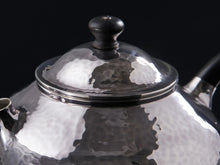
An old saying goes: "Seven treasures for literati, piano, chess, calligraphy, painting, poetry, wine and tea."
Drinking tea around the stove in winter is the most heart-warming.
While cooking slowly, wait by the stove for the water to boil, the air to rise, and the fragrance of tea to burst forth. Find a moment of peace and purity in the trivial matters of the world.
And a wonderful tea event is inseparable from a good pot.
Xu Cishu once recorded in "Tea Shu": "Tea notes are good if they are not affected by others, so the first silver and the second tin."
Silver is a beautiful silver-white metal with good ductility. Silver teaware has also been admired by celebrities and scholars in the past dynasties. It has been a symbol of status since ancient times. Our use of silver teapots can be traced back to before the Warring States Period and flourished in the Tang Dynasty In the Song Dynasty and all dynasties, it was said that "the silver pot is the most precious for boiling water, and the silver pot is the most respected for making tea.
Lu Yu, a tea sage, loved tea all his life and was proficient in this way. He once mentioned in the "Tea Classics": "Using silver to make pots is elegant and clean, which can completely maintain the original taste of tea and be used for a long time."
"A hand falls into one hammer, and four hammers form a pattern."
Each handmade silver teapot is a precious tea vessel, and at the same time it is also a fine work of art.
Today, Tongxinshe Teahouse will bring you the "Ball and Hammer Pattern Teapot" from "Hung Kee Treasure", a century-old teapot maker family
The capacity of this pot: 150ml, the weight of the pot: about 123g, one piece of punching process, the whole body is hammered with the classic hammer pattern technique, the body of the pot is drummed, the mouth is closed, the spout is punched out with one mouth, and the built-in ball hole is really an excellent tool for making tea. , The official hat-shaped pot lid is equipped with mahogany dripper, commensurate with the handle of the pot. It can prevent scalding when making tea and pouring water. It is practical and exquisite. It is made by Master Hong Jike and comes with a collection certificate.
The "Hongji Treasure" in Heqing, Yunnan Province began in the Guangxu period of the Qing Dynasty. It has been passed down for five generations and still insists on using traditional pot-making techniques to make pots. Mr. Hong Jike, as the fourth-generation heir of "Hongji Treasures", is proficient in a variety of hand-made pots. Hong Jike, a Bai nationality, was born in 1971. The fourth generation successor of "Hung Kee Treasure". The ninth batch of intangible cultural heritage projects in Heqing County, the representative inheritor of silver jewelry forging skills (Heqing silverware forging skills).
Five generations of ancestors are silversmiths. He learned the traditional crafts of gold, silver and copper handicrafts from his father since he was a child. In 1988, he was able to independently complete the production of metal crafts. In 2005, he went to Tibetan areas to engage in the production of Tibetan Buddhist supplies. During this period, he designed and produced "Golden Buddha Statue". In 2007, he returned to his hometown and began to make sterling silver pots and sterling silver tea sets. After more than 30 years of hard work, excellent works have been produced frequently, and the works have been collected many times. The creation style is diversified, with profound meaning and originality.
One punch is a traditional craft, which means that in the process of making the pot, the whole pot body including the bottom of the pot is made of one piece of silver sheet instead of being made separately and then welded. "One punch" is based on the craft The degree of difficulty is mainly divided into three levels: one punch for the body, one punch for the mouth and the rare one for the mouth and ears.
The body of the pot is punched in one piece, which means that the body and the bottom of the pot are punched out of a piece of silver, and the spout is welded to the body of the pot. Although relatively common, pot makers need at least five years of work to master it.
The mouth is punched out, also known as the mouth punched integrated pot. On the basis of the body of the pot, the spout is also punched out of the pot.
The mouth and ears are punched together, and the craftsmanship is even more rare. It is based on the integrated pot with the mouth, and the ears of the pot are also punched from the body of the pot. There are even fewer craftsmen who can master it skillfully, so it is even more precious.





















